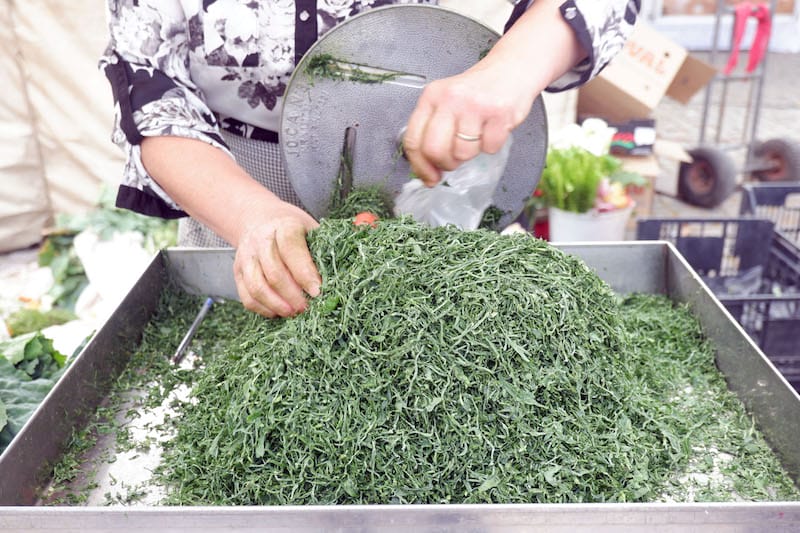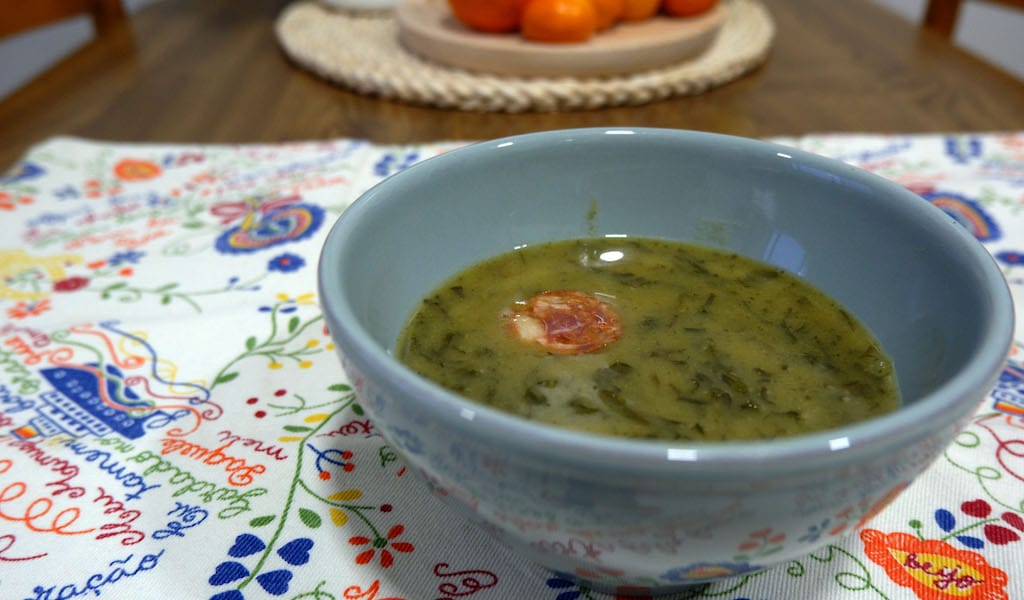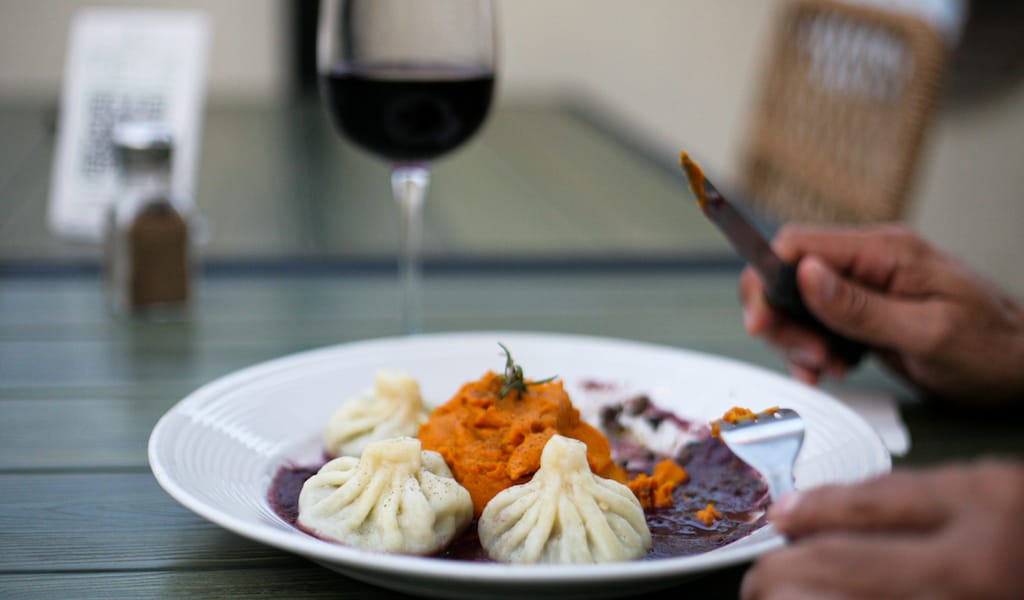Caldo verde, Portugal’s most famous soup, doesn’t sound like much in English – “green broth” is the literal translation. I was thinking about this when reading an article on the 20 best soups in the world, which a friend sent to me, noting that caldo verde (a “homey soup” where “thinly sliced greens meld with potatoes and onions”) had made the cut.
The article refers, in general, to the restorative power of soup, a belief that is held in very different cultures across the globe – which sounds about right to me. But then the author references a book that broadly defines soup as “just some stuff cooked in water, with the flavored water becoming a crucial part of the dish.” And I have to disagree there, because caldo verde is so much more than flavored water. How to explain that it is a feeling?
Let’s dive deeper into the caldo verde’s story, which begins sometime in the 15th century up in northern Portugal – Minho, to be more precise. It was an area of little wealth, and so they rustled up humble ingredients to make a soup that is equal parts filling and delicious. It began life as – and still is – a soup more typical of rural areas, but nowadays almost every restaurant in Portugal, whether a down-home spot or gourmet place, serves caldo verde. Any Portuguese person who arrives for a meal and is asked, “How about a caldo verde to start?” will almost surely say yes. A caldo verde always goes down well, especially when accompanied by bread (corn bread, preferably) and a glass of vinho verde.
Any Portuguese person who arrives for a meal and is asked, “How about a caldo verde to start?” will almost surely say yes.
The song “Uma Casa Portuguesa” (“A Portuguese House”), immortalized by the famous fado singer Amália Rodrigues, says it best: “Just a little, little to cheer up / A simple existence / It’s just love, bread and wine / And a green, green broth steaming in the bowl / It’s a Portuguese house, for sure.”
While soup is usually associated with cold nights, caldo verde is eaten any time of year, at any time of day. In Porto, a clay bowl of the soup is a must-eat during the festivities honoring São João (June 23), either as a side to the ubiquitous grilled sardines or later in the night, to replenish your energy during the non-stop party. But it’s also an everyday thing – I’ll get a bowl when deciding whether to order bifanas stuffed between bread or on a plate at Conga.
In fact, caldo verde pleases palates all over the country, and it’s said that it has already crossed the Atlantic, where it’s popular in Brazil. In 2011, the Portuguese chose caldo verde as one of the “Seven Wonders” of the country’s gastronomy. While I didn’t vote, I agree wholeheartedly with the decision.

All this talk gets my appetite going, so I put on my shoes and head to the fruit and vegetable market near my house, all the while thinking how lucky I am to be able to buy the fresh produce needed to make one of the 20 best soups in the world. A bag of kale (already sliced thin), chorizo (“Spicy, miss?” the vendor asks. “Yes, please!”), potatoes (“If it’s for caldo verde, take this one, it crumbles more,” says the woman at the produce stand) and onions (“These are from my hometown,” she adds). Around here, everyone knows what it takes to make a good caldo verde.
Cooking caldo verde is more art than science, but I’m curious what the Internet has in the way of recipes. After a quick search, all I see are images that look like anything but a perfect caldo verde. I prefer my mother’s way, even though I don’t have her recipe written down – she taught me how to make caldo verde by feel.
So that’s what I do. In a pot of boiling water, I add the chopped potatoes, onions and garlic cloves. Then one chunk of chorizo, which serves to flavor the broth. After they’re cooked, I remove the chorizo and take an immersion blender to the pot’s remaining contents. Only then does the kale come in – I throw in as much sliced kale as will fit in the pot, and then add the rest of the sliced chorizo and salt to taste. After three or four minutes of simmering, the soup is done. Serve with a drizzle of olive oil – only a drizzle! If you overdo it, you’ll spoil the soup.
It’s the perfect recipe for caldo verde. No secrets, no fuss. Just an incredible amount of flavor. There are those who eat the kale with a fork, but I think it’s best with a spoon – that way you get some of the “green broth.” And the chorizo is always eaten at the end. All you need now is love, bread and wine, and you’ve got a Portuguese home.
 February 20, 2014 Barba
February 20, 2014 Barba
Editor's note: [We're pleased to report that Barba has reopened in a new location. See […] Posted in Istanbul September 22, 2021 Khinkali Chronicles, Part IV
September 22, 2021 Khinkali Chronicles, Part IV
Snail khinkali? It might sound, at first, like an odd combination. On closer […] Posted in Tbilisi January 19, 2022 Rincon Criollo
January 19, 2022 Rincon Criollo
"Everything had to remain the same." In the dining room of Rincon Criollo, a Cuban […] Posted in Queens
Cláudia BrandãoCláudia Brandão
Published on April 16, 2021
Related stories
February 20, 2014
IstanbulEditor's note: [We're pleased to report that Barba has reopened in a new location. See below for address.] We're going on a Global Bar Crawl this week, and today we're stopping at a building in Istanbul that has five floors of bars and clubs. Tomorrow we head to Mexico City for some mezcal. We like…
September 22, 2021
Tbilisi | By Jason Alexander
TbilisiSnail khinkali? It might sound, at first, like an odd combination. On closer consideration of Georgian cuisine and history, however, it makes good sense. For one thing – perhaps the most important – they’re tasty, and we have yet to hear anyone who’s tried them disagree. The signature dish at Metis restaurant, which is –…
January 19, 2022
Queens"Everything had to remain the same." In the dining room of Rincon Criollo, a Cuban restaurant in Corona, Esther Acosta recalls the pledge that she and her older brother, Rudesindo ("Rudy") Acosta, made to their great-uncles when they took the reins of the family business. The surrounding community has changed in the years since the…

















































































